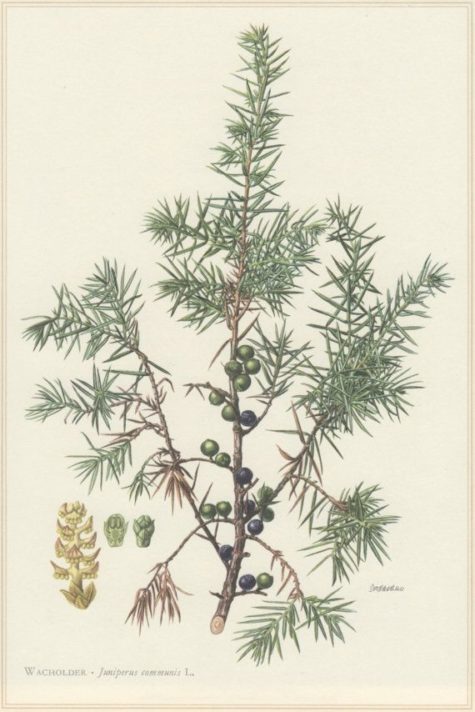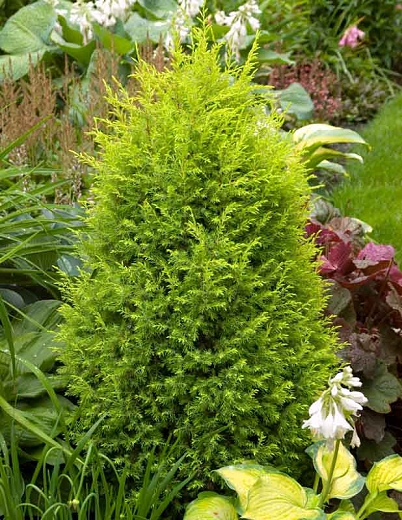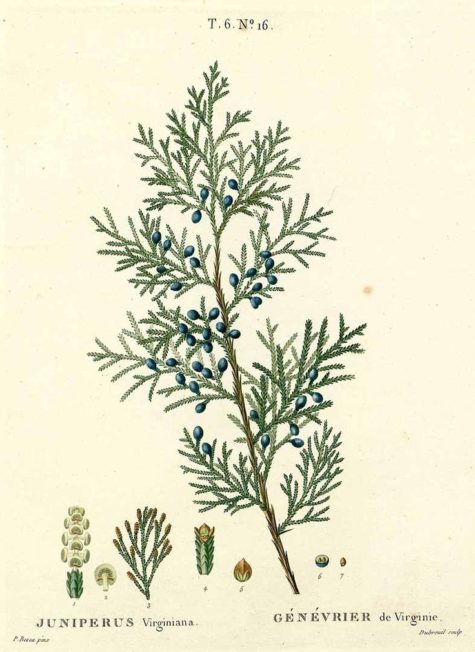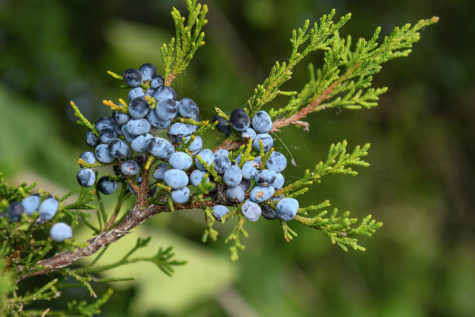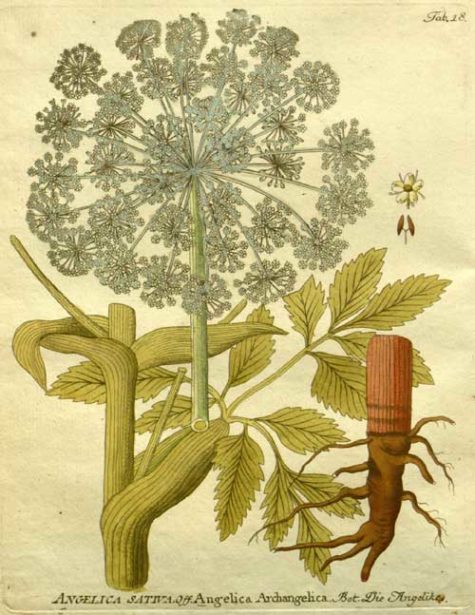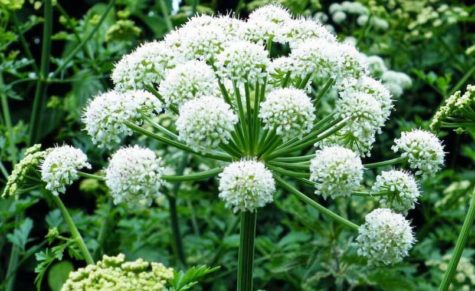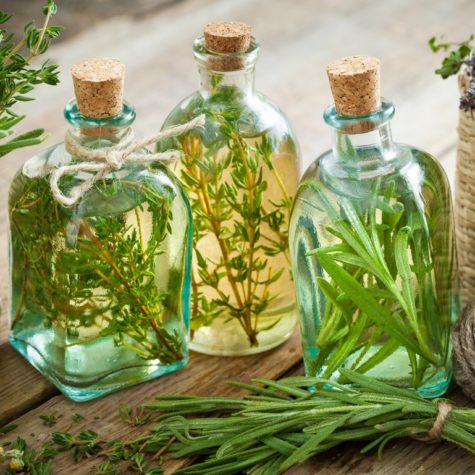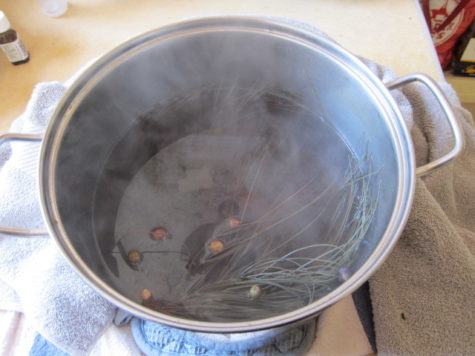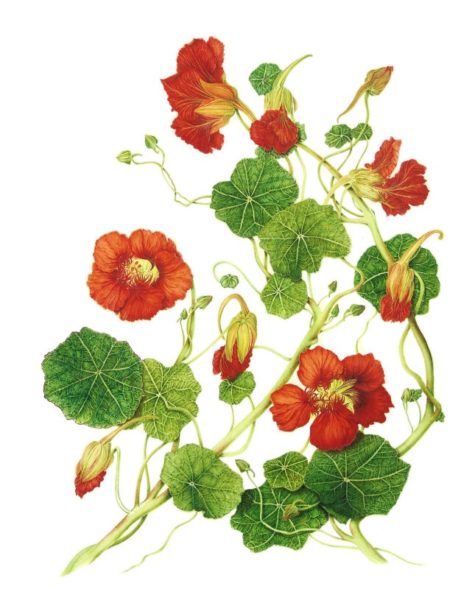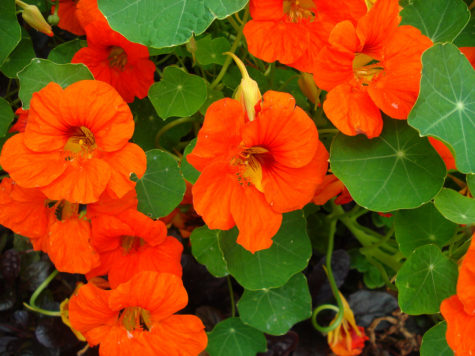Antimicrobial
Juniper
- Scientific Name: Juniperus, communis
- Plant Family: Pinaceae
- Parts Used: Berries, leaves and twigs, bark
- Constituents: Rich in essential oil which contains monoterpenes and sesquiterpenes, invert sugar, flavone glyosides, resin, tannin, organic acids
- Actions: Diuretic, Stimulant, Carminative, Emmenagogue, Antimicrobial, Anti-rheumatic, Abortifacient
- How does it work? Juniper berries contain chemicals that might decrease swelling. It might also be effective in fighting bacteria and viruses. Juniper might also increase the need to urinate.
Varieties:
There are over sixty Juniper species, but the one which yields edible fruits in Britain is Juniperus comunis. In the Americas, Eastern Red Cedar, Juniperus virginiana, can be used in much the same way. A detailed account of the herbal properties of Eastern Red Cedar can be found here.
Among the varied forms, there are dense, columnar trees; medium sized, rounded shrubs; irregular bush forms; and creeping prostrate types. Irish and Swedish junipers are tall, narrow, and quick growing; the Greek and Chinese are very compact, slow growing. Pfitzers are irregular, massive types. California Juniper may reach heights of 40 feet, and shore Juniper and japonica are spreading ground covers.
Notes and Cautions:
One useful guide to the identification of Juniper is the apple-like fragrance that the needle-shaped leaves give off when crushed.
Women who are pregnant, wish to become pregnant, or who are nursing a child should not eat Juniper fruits. Due to their action on the kidneys, Juniper berries should be avoided by persons with kidney disease.
Don’t confuse Juniper berry oil with cade oil, which is distilled from Juniper wood (Juniperus oxycedrus).
The Basics:
A strong aromatic scent emanates from all parts of the shrub. Berries taste slightly bitter-sweet, fragrant, and spicy and are generally used to make a tea that is good for flatulence and indigestion, to promote the flow of urine.
Juniper branches can be used as a fumigant and were commonly burned in public places in times of plague and pestilence. This was still the practice in French hospitals a century ago during the smallpox epidemic of 1870.
Juniper berries make an excellent antiseptic in conditions such as cystitis. The essential oil present is quite stimulating to the kidney nephrons and so this herb should be avoided in kidney disease. The bitter action aids digestion and eases flatulent colic. It is used in rheumatism and arthritis. Externally it eases pain in the joints or muscles.
Some people take Juniper by mouth for problems with digestion, urinary tract infections (UTIs), and kidney and bladder stones along with many other conditions. Some people apply Juniper directly to the skin for wounds and pain in joints and muscles.
In foods, Juniper berry is often used as a condiment. The extract, oil, and berry are used as flavoring ingredients in foods and beverages. In manufacturing, Juniper extract and oil are used as fragrances in soaps and cosmetics.
Eastern Red Cedar
- Scientific Name: Juniperus virginiana
- Parts Used: Berries (female cones), branches, leaves, bark
- Actions: Anti-inflammatory, Diaphoretic, Expectorant, Astringent, Antimicrobial, Diuretic, Antiasthmatic, Antifungal
The uses of Eastern Red Cedar branch out into many. They are very similar to the Old World, standard Common Juniper in that its female cones- or berries- are one of its favored usable parts, if not an attribute of the plant that really grabs the eye. When you see the Cedar’s fragrant branches heavily-laden with these bright blue little “fruits,” it’s hard for an herbalist to think that these are NOT somehow useful!
One of the virtues of the berry is that it goes impeccably well with several mediums: salve, tincture, elixir, syrup, you name it. What more: it tastes delicious, and mixes well with a large variety of other herbal flavors in combination, if you are crafting a blend or formula of sorts. The twigs, leaves, branches and bark of Cedar have effects and flavor too, although they are notably more intense and astringent, having a reputation of being hard to extract; their use is important, but not as eclectic.
I would wager that the berries are more for tonic use, whereas the rest of this beautiful plant should be saved for acute situations, which I will get to later. Berries can be picked during the fall or winter, as they last, when they “ripen” to an appetizing-looking blue.
Remember: Cedar trees tend to be dioecious (at least the Eastern Reds are). That is, there are males and females of the species. If it is fall or winter, and the trees you are looking at for harvesting don’t seem to have blue cones, chances are they are male. Keep looking– you will more than likely stumble upon a female tree not far off.
In its many mediums, the berries serve as a very ideal winter medicine– all the better since they can, for the most part, be harvested all winter as the berries are available. They are high in Ascorbic Acid, or Vitamin C, an ideal vitamin to take over the winter for immune support. Even if you don’t have a cold, their use as a tonic will be more than welcome.
When winter illnesses take a nasty turn, Eastern Red Cedar berries work with expectorant action, helping the lungs clear out excess mucus and promote a healthy cough. It can be useful for a dry or wet cough: it relieves that “tickle” you may feel with a scratchy, dry throat with a hoarse cough, but it also stimulates the lungs to cough more productively, and expel phlegm in less time than without it. So here you have a medicine that stimulates the immune system, relieves a scratchy throat, improves your cough– and tastes great!
Cedar berries in syrup form are especially delightful. Sounds like quite a valuable ally to have, if you ask me.
Medicinal Uses
The young leafy twigs of the red cedar were officially listed in the U.S. Pharmacopoeia from 1820 to 1894 as a diuretic. The distilled oil of the red cedar has been officially listed as a reagent in the U.S. Pharmacopoeia since 1916.
The berries in decoction are diaphoretic and emmenagogue, like those of Common Juniper, and the leaves have diuretic properties.
People take Eastern red cedar for cough, bronchitis, joint pain (rheumatism), water retention, and flatulence. They also take it to improve appetite and digestion, and as a treatment for fungal infections and worms.
People apply Eastern red cedar to the skin for wounds, skin rashes, hair loss, eczema, acne, warts, fungal skin infections, and hemorrhoids. They also rub it onto joints for rheumatism, and onto the chest for asthma.
In the Native-Hispanic tradition, Cedars and their relatives are valued highly for the properties of their leaves, “needles,” or branches. These hold the more potent effects of the tree, and as such, are more difficult to capture in preparations. They can be slightly toxic.
The berries are used when there are excess fluids in the body, but Juniper really shines when the kidneys are sluggish, dilating tissues to increase urine flow, and reducing excess mucus production. It’s diuretic actions are truly remarkable, and is indicated in many cases of edema. Those berries are irritating, though, and are not recommended in large doses, for long-term use, and definitely not for those with kidney problems.
Eating 3-5 fresh berries is suggested for an upset stomach. It is thought the bitter nature stimulates gastric juices and improves digestion.
While certainly not widely considered poisonous or dangerous, it is still good to be careful. Be sparing when using preparations of Cedar needles or branches, even the berries, for that matter. Cedars are very powerful diuretics. When taken overboard, they cause kidney irritation, which feels like cramping in the abdomen– similar to a period cramp. Even higher doses can be more dangerous. Folks with weak kidneys, or outstanding kidney issues should avoid using the Cedar leaf.
Angelica
- Scientific Name: Angelica archangelica
- Plant Family: Umbelliferae
- Parts Used: Root, seed, stems
- Actions: Alterative, Antimicrobial, Aromatic, Bitter, Carminative, Circulatory Stimulant, Diaphoretic, Diffusive, Emmenagogue, Expectorant, Grounding, Nervine
Notes: Angelica archangelica is not the same plant as Chinese Angelica (A. sinesis), often referred to as dong quai or dang gui. There are about 30 varieties of Angelica, but Angelica archangelica is the only one officially employed in medicine.
Cautions: Use care when wildcrafting, as it resembles both Queen Anne’s Lace (a benign wild carrot) and Water Hemlock (a poisonous plant).
The Basics:
Angelica is a stunning white flower that looks like a white starburst exploding across the green hillsides. One of Iceland’s most cherished herbs, it is not only beautiful, but also appreciated as a nutritious food, a liqueur and an herbal remedy. The roots and stems can be boiled or pickled and are considered a delicacy in all of Scandinavia. The stems were used to make a musical flute, as well as flavor reindeer milk or be crystallized in sugar for desserts.
Angelica is a veritable giant in the herb world. The towering plant is widely traveled and has a background rich in herbal lore. Use has been made of leaves, stems, roots, and seeds in cooking and in medicine.
Angelica is used for heartburn (dyspepsia), intestinal gas (flatulence), loss of appetite (anorexia), overnight urination (nocturia), arthritis, stroke, dementia, circulation problems, “runny nose” (respiratory catarrh), nervousness and anxiety, fever, plague, and trouble sleeping (insomnia).
According to WebMD, Angelica contains chemicals that might kill cancer cells and fungus, reduce anxiety, and settle the stomach.
Some women use Angelica to start their menstrual periods. Sometimes this is done in hopes of causing an abortion. Angelica is also used to increase urine production, improve sex drive, stimulate the production and secretion of phlegm, and kill germs.
Some people apply Angelica directly to the skin for nerve pain (neuralgia), joint pain (rheumatism), and skin disorders. In combination with other herbs, Angelica is also applied to the skin for treating premature ejaculation.
Angelica is also used as a smell in aromatherapy to reduce symptoms associated with quitting tobacco (nicotine withdrawal).
It should be noted that Angelica has a tendency to increase the sugar in the urine, so those with a tendency to diabetes should avoid it.
A strong volatile oil is present in all parts of the plant, but especially in the root, and Angelica is effective as a general tonic. Eating Angelica stalks is said to relieve flatulence and soothe “a feeble stomach.”
Drinking Angelica tea is said to promote urine and perspiration. It is also reputed to cause a strong dislike for alcohol and is sometimes used as a treatment for alcoholics.
Strain the tea to make a cool bath for tired eyes or a wash to cleanse the skin. The scented leaves are an ingredient in potpourri. Bees and wasps are attracted by the abundant nectar on Angelica flowers.
Continue reading
Making Herb-Infused Honey
Herbal honeys are profoundly medicinal and they taste great. When herbs are infused into honey, the honey absorbs all the water soluble components of the herb and all the volatiles (essential oils), as well. This yields an excellent extraction of the herb’s complex chemistry and preserves it very well.
Administration and Dosage Guidelines
For internal use, herb-infused honeys can be taken as they are. More often, though, they’re used as ingredients in composite remedies, such as elixirs, oxymels, or syrups. Herbal honeys are also applied topically for skin blemishes, wounds, burns, etc.
If taken straight up, teaspoon and tablespoon doses of herb-infused honey will deliver an effective dose of herbal constituents.
Shelf Life and Storage Guidelines
Finished herbal honeys should be stored in sealed glass jars, away from light and heat. They will retain their potency for many years.
Necessary Tools, Equipment, or Ingredients
- Fresh herbs
- Honey
- Wide-mouth jars
- Wire mesh strainer
- Labels
Preparing Remedies – Step by Step
Coarsely chop your fresh herbs and allow them to wilt for a few hours before infusing.
Put your herbs into a wide-mouth jar and fill half to three-fourths full.
If the honey you’re working with is a liquid consistency, simply pour it into the jar up to the shoulder. If it’s solid or semi-solid, gently warm it to get it runny. This is easily done by setting the honey jar in a pot of hot (but not boiling) water for 10 to 20 minutes. The honey will soften and become easier to pour.
Using a chopstick or spoon, stir and work the herbs around in the honey. Close securely and label the jar with the date and the herbs used.
Place in a warm area (like on top of the refrigerator) and leave to macerate (infuse into the honey) for 4 weeks.
Gently warm the closed jar in a pot of hot water until the honey has a liquid consistency, then strain into a new jar. Press the herbal residue (marc) against the strainer to express as much honey as you can.
Be sure the finished jar of infused honey is labeled with the herbal ingredients and the finish date. Store in a cool dark place.
Pros
- Honey’s innate benefits.
Even before infusing with herbs, honey is an excellent wound healer and antimicrobial agent with a long history of use.
- Long shelf life.
Honey is an incredible preservative. You can expect your infused honey to last for years and retain its effects.
- Delicious.
Getting someone to take a honey medicine never seems to require much bargaining, even with kids and those who have picky palates.
Cons
- Sweet means sugar.
Herbal honeys taken alone are not ideal for those with insulin resistance, diabetes, or other blood sugar regulation problems. (When mixed into an oxymel or elixir, though, this concern is minimal).
- Potential fermentation.
Because we’re infusing fresh herbs into honey, there’s the possibility that the water content of the herbs will thin out the honey, making it sufficiently liquid to allow it to ferment spontaneously.
- Preparation time.
Infused honeys take 1 month or more to prepare.
Additional Considerations
Choose local honey whenever possible. Aside from supporting local beekeepers (and local bees), honey made in your area will help you acclimate to pollen and reduce seasonal allergies.
Raw, unfiltered, unpasteurized honey has the most medicinal efficacy, but don’t worry too much if you can’t find this in your area. Most studies on honey as a wound dressing have been done with processed and irradiated honey, and it’s still very effective.
Do be aware that some “honeys'” sold in stores have been found to contain high fructose corn syrup or other adulterants. Make sure your honey is actually honey!
Source: Herbal Medicine for Beginners
Making Herb-Infused Vinegars
Vinegar is a useful solvent (the technical term is menstruum) for herbal extracts. Its acidity helps draw out certain constituents called alkaloids, which are often some of the most potent chemicals in an herb. It also helps dissolve plant cell walls and release mineral content. Apple cider vinegar is standard in these preparations.
Administration and Dosage Guidelines
Herbal vinegars may be useful as remedies in their own right, or they may be combined with honey to make an oxymel.
Herb-infused vinegars are frequently taken in doses of 1/2 to 1 fluid ounces at a time.
Shelf Life and Storage Guidelines
Like tinctures, store herbal vinegars in dark, light-blocking glass bottles in a cool, dry place. Vinegars will last at least 6 months and up to several years.
Necessary Tools, Equipment, or Ingredients
- Herbs. If using fresh, let wilt for a half day or so spread out on brown paper bags or a clean tabletop, this will allow some water content to evaporate. Then chop or run through a blender before you put in the jar and add the vinegar.
- Apple cider vinegar
- Mason jars of various sizes for maceration
- Dose and storage bottles
- Strainers
- Funnels
- Labels
Preparing Remedies – Step by Step
Fill a mason jar half to three-fourths full with the herb you want to tincture. If using roots, which tend to swell in liquid, stay on the half-full side. If using leaves or flowers, fill to the three-fourths mark.
Fill the jar to the top with apple cider vinegar.
If using a mason jar with a metal lid, insert a piece of wax paper under the jar lid before screwing down the ring. The vinegar fumes will degrade the coating on the underside of the jar lids. If you like, use plastic lids instead to avoid this issue.
Close securely and label the jar, including the date you started. For example: Nettle infused vinegar, 4/3/2019.
Macerate (allow the herbs to infuse in the vinegar) for 4 weeks. Shake the bottle every day or so to encourage maximum constituent release. Otherwise, keep in a cool, dark place.
Strain, re-bottle in colored glass vials, and add the finish date to the label.
Pros
- Vinegar’s innate benefits. Taken internally, vinegar stimulates digestion and can help with blood sugar control. Topically, it has antimicrobial, antifungal, and anti-inflammatory effects. Adding herbs enhances these further.
- No alcohol. Vinegar extracts can be given in place of tinctures for those who can’t consume alcohol, though they’re not quite as strong.
Cons
- The acidity. For some people who have heartburn or ulcers, vinegar’s acidity can be too irritating to tissues already tender and inflamed.
- Preparation time. Infused vinegars take at least 2 to 4 weeks to prepare.
Additional Considerations
Always use high-quality, preferably raw, apple cider vinegar – not distilled white vinegar. Raw apple cider vinegar has probiotic content that can be helpful in some circumstances, like when making a digestive formula as a vinegar extract.
Source: Herbal Medicine for Beginners
How To Make Herbal Steams
Herbal steams are excellent for addressing issues in the lungs and sinuses, the face, and eyes. The evaporating steam carries light chemicals from the herbs, including some with antimicrobial, anti-inflammatory, relaxant, and immune-stimulating effects. These get into direct contact with the respiratory tract and skin, exerting their effects strongly.
Administration and Dosage Guidelines
Administer a steam whenever you want to stimulate the surface or respiratory tissues with moist heat. For acute illness, it’s best to steam at least twice a day. For ongoing skin or respiratory support, once a day is sufficient.
Shelf Life and Storage Guidelines
Steams are made on as-needed basis. They are not stored. Dry herbs blended for an herbal steam formula can keep for years if they’re stored in airtight containers.
Necessary Tools, Equipment, or Ingredients
- Herbs
- Water
- Gallon-size or larger pot
- Towel or blanket
Preparing Remedies – Step by Step
- On the stove, boil 1/2 to 1 gallon of water in a covered pot.
- Once at a full boil, remove from the heat and place the pot on a heat-proof surface.
- Make a tent by draping a blanket or towel over your head.
- Remove the lid from the pot and add 1/4 to 1/2 cup of your herb mixture to the water.
- Position your face over the steam and remain there for 5 to 20 minutes, catching the steam with your tent.
- For respiratory issues, inhale the steam as deeply as you can so the medicated steam gets deep into your lungs.
- Keep a handkerchief nearby – the steam will clear your sinuses and make your nose run.
Pros
- Delivers the medicine where it’s needed.
Particularly for antimicrobial effects, steam is the most direct method for getting the herbs in contact with the respiratory tract tissues.
- Stimulating but soothing.
The warmth and moisture of steams help activate immune function in the mucous membranes and at the same time relieve irritation and calm a cough or ease difficult breathing.
Cons
- Takes time. Between preparation and execution it can take at least 30 minutes to conduct a good effective steam.
- Not portable. Steams require some space and a stove to make effectively, so they’re mostly done at home.
Additional Considerations
After steaming, you can use the leftover liquid – it is essentially a hot infusion. Drink it, soak your feet in it, soak a cloth and make a compress, or employ it in some other way so nothing is wasted. If nothing else, let it cool and feed it to your garden or houseplants. Plants like tea, too.
You can also make a good steam using essential oils. Simply boil water and set up your steaming station as directed, but instead of adding dry herbs, tap in 10 to 30 drops of essential oil. DO NOT however, drink the leftover liquid when done steaming. It can, however, be used as a foot soak.
Source: Herbal Medicine for Beginners
Nasturtium
- Scientific name: Tropacolum majus
- Plant family: Tropaeolaceae
- Note: It should not be confused with watercress, whose Latin name is Nasturtium officinale.
- Parts Used: The fresh or dried leaves, flowers, and the seed pods.
- Medical Action: Anti-microbial, anti-bacterial, anti-viral
- Constituents: Glucosilinates; unknown anti-bacterial substance, vitamin C
The flowers contain about 130 mg vitamin C per 100 grams (3.5 oz), about the same amount as is contained in parsley. Moreover, they contain up to 45 mg of lutein per 100 gr, which is the highest amount found in any edible plant.
The Basics
Nasturtium is quite a powerful anti-microbial, especially when used as a local remedy for the treatment of bacterial infection. Internally it can be used with benefit in any bacterial infection but it is especially indicated for respiratory infections suchas bronchitis.
It has been found to be beneficial in influenza and the common cold. Some herbalists report it to be indicated in infections of the female reproductive organs.
Nasturtium is mostly taken fresh by adding leaves, flowers and seed pods into salads and other edibles. The plant is antimicrobial, so it is good to eat this herb for infections. It is useful for respiratory infections like bronchitis, flu and colds, and it is also helpful for reproductive infections. It can help clear mucous from the throat and lungs.
By taking herbal tincture when you first feel a cold coming on, you can help speed that cold on its way. The seed pods may be antifungal. Tinctures can be made in alcohol or vinegar to preserve the nutrients of the plant for later use. Vinegar can be put on cooked greens for a mustardy touch.
The mustard oils contained in nasturtium have an antibacterial and antiviral effect and can protect against infectious and undesired yeasts such as candida. They can be used to relieve pain, improve wound healing, treat digestive disorders and bladder infections and infections of the upper respiratory tract.
Description
Nasturtium is found in many gardens with its round flat leaves and bright cheery flowers. It comes in many different colors and some varieties have variegated leaves as well.
Nasturtium is both a decorative garden annual as well as a useful culinary herb. There are two types of nasturtium; a trailing type (Tropaeolum majus) that can be trained to climb or allowed to spread on the ground and a bush type (Tropaeolum minus) that forms loose mounds.
Nasturtium produces colorful flowers all summer and has attractive water lily-like foliage. It is useful as a plant for garden beds as well as for containers. The big beautiful flowers and leaves with their unusual shield-like shape are particularly striking and ornamental. The plant forms up to 4 m long shoots that bear flowers throughout the year.
Because it is not hardy, all this splendor sadly ends with the first frost. Continue reading
Rennie Luttrull: queen-annes-lace-seeds
Rosanna: Spignel aka Bald Money
Annamarie Squatrito: Fumitory
EILEEN Klinghagen: Pumpkin
Mahmudul Hasan: Celery
